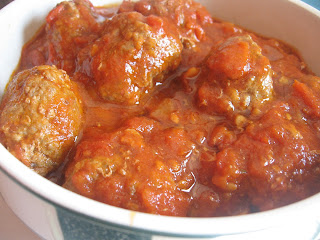 |
| Copyright 2013 LtDan'sKitchen blogs |
The dish they served was a bit thick on the sauce and was perfect when paired with naan or roti. I tried making my own version of this dish using a Madras curry powder mix and it was quite tasty. However, I found another version where pureed tomatoes are added to thicken the sauce and I thought I'd give it a go. Not having a functional blender at the moment, tomato paste will have to do however. I also decided to use quail eggs instead of chicken eggs. Aside from being aesthetically appealing, I just thought that quail eggs were not as imposing as chicken eggs in terms of eating them whole.
I made use of Asian chili powder when I made this dish and it came out really spicy. If you cannot take the heat, use the regular chili powder from McCormicks. It will give you a hint of heat but never too much that it will leave you gasping for water. I actually had to make some cucumber raita to help cool off the heat. Other than that, this is one tasty dish.
Anda Curry (Egg Curry), Adapted*
3 trays quail eggs, (24 pcs per tray)
4 tbsp vegetable oil
2 tbsp tomato paste
3 cups water
2 large onion, grated
3 garlic cloves, grated
1 tbsp fresh ginger, grated
2 green chilis, deveined, deseeded and diced finely
2 tsp coriander powder
1 tsp cumin powder
1 tsp garam masala
1/2 tsp turmeric acid
1/2 tsp red chili powder
salt and pepper
1. Boil the eggs in a pot with enough water. Cook until hard-boiled. Allow to
cool for 5 minutes and peel off the shell. Set aside.
2. In a large pan, roast the coriander, cumin, and red chili powders with the
garam masala and turmeric acid over medium heat. Once they start to
release their aroma, add the oil and mix well.
3. Add the ginger, onions, green chili and garlic. Saute until softened. Season
with salt and pepper. Add the water and bring to a boil.
4. Once boiling, lower the heat to medium low and add the tomato paste.
Adjust the flavor with salt and pepper. Cover and simmer for 10 minutes.
5. Add the cooked eggs and simmer for another 5 minutes. Check for flavor
and adjust accordingly.
6. Garnish with fresh cilantro leaves and serve with steamed rice.
* Indian Curry: About.com








